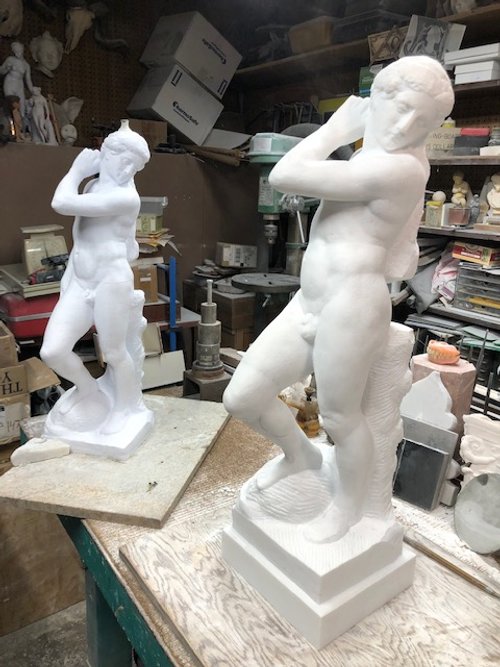Reproductions of Michelangelo’s “Prisoners” or “Captives”
In 1505 Pope Julius II commissioned Michelangelo to create his tomb. There were over 40 statues planned for the original tomb, and 16 of them were destined to be slaves. Symbolically, these struggling figures were meant to represent the liberal arts held captive after the Pope’s death. The first of these, called the Dying Slave, was completed in 1513 after the Pope had died.
There are 6 Slaves, two of which are in the Louvre and the remaining four are in the Accademia in Florence. These four, made between 1520 and 1523, were found in Michelangelo’s workshop after his death in 1564.
These are also the famous “non-finito” sculptures, which has been identified with the sculptor where he sought to liberate the forms of the figure from the rough block. The array of tool marks shows the process of the creation of a statue in marble.
I am offering 24 inch replicas of the Dying Slave, Rebellious Slave, Young Slave and the Bearded Slave, as well as his unfinished Apollo, located in the Bargello in Florence. Each is crafted in high grade Statuario marble from Carrara.
Please contact me for more information!
Guide for beginners: selecting tools
MATT’S GUIDE FOR BEGINNERS: STONE CARVING TOOLS
My adage is “get the best you can afford.” Temper this with expense vs. how many hours a week/month/year you will use the tool.
3 angle grinders:
7” fixed speed cutter, 4 hp, 8500 rpm
4.5” or 5” fixed speed cutter 7.5 to 10 amp, 11,000 rpm
5” variable speed for grinding and sanding, 13 amp, 2,800 to 11,500 rpm
Bench grinder
½ HP, 6 “ diameter wheels by 1” wide.
To grind tungsten carbide chisels you will want a “green wheel” grinding wheel, which does not come installed on typical bench grinders.
Diamond disk blades with flange for flush cutting. Learn how to flush cut with the dust flying away from you.
Air Hammers:
Cuturi Tipo U for roughing out and finishing small to medium sized blocks
with ½” shank pneumatic chisels
Cuturi Tipo E
with ¼” shank pneumatic chisels
Cuturi Tipo T for heavy roughing out
with ½” shank pneumatic chisels
Air Compressor
The essential items to note with choosing an air compressor are CFM (cubic feet/minute), PSI (pounds per square inch), HP (horse power) and tank size. Manufacturers of air hammers recommend 3 to 8 cfm, 90 to 100 psi and a minimum 20 gallon tank. Other options are stationary or portable and horizontal tank or vertical. You will typically be choosing between a 2 hp and a 5 hp compressor. Consider that with a strong compressor you can use pneumatic grinders and sanders, which are typically cheaper than electric models and last longer.
Choosing chisels:
½” shank pneumatic tungsten tipped chisels from Italy are sized in mm.
For starters, I suggest beginning with the essential “work horse” chisel. This is a 7mm for manual chisels and 8mm for ½” shank pneumatic chisels. If you can only acquire a small number of chisels I suggest a 5mm, 7mm and 9mm for tungsten tipped manual and 6mm, 8mm and 10mm for ½” shank tungsten tipped pneumatic chisels. Buy as many as you can afford. You will need rounded and flat chisel for each size.
Ditto with ¼” chisels.
Ideally, you will have one complete set for roughing out and a set for finishing.
Hand chisels:
Points, buy tempered steel not carbide in various sizes, perhaps the most important chisel in your inventory. I buy the Mueller or Kapriol point chisels in bulk, 6 piece packages.
Tooth chisels, I prefer carbon steel toothed chisels to tungsten because the carbon steel chisel can be forged to be thinner than the tungsten chisel and this provides a smoother cut. Carbon steel chisels are less expensive and can be re-forged.
Pitcher, A pitching chisel is very useful but consider that your hammer can do much of the same task.
